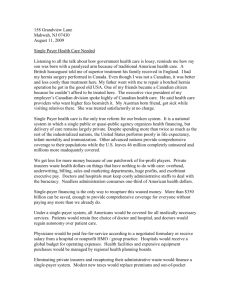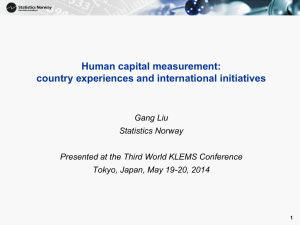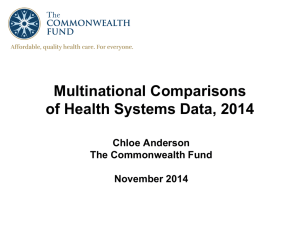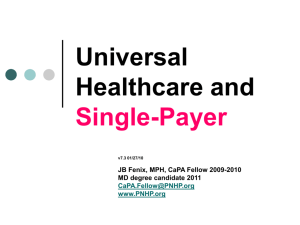The PPACA: Implications for Hawaii
advertisement
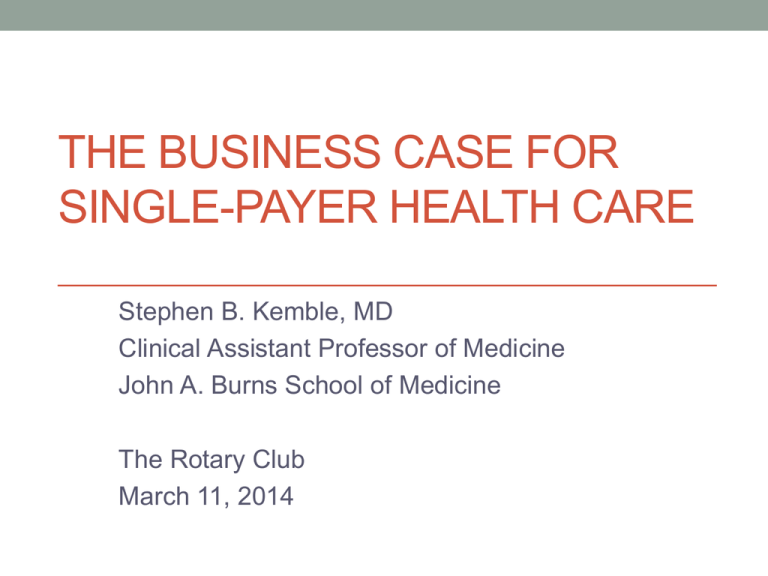
THE BUSINESS CASE FOR SINGLE-PAYER HEALTH CARE Stephen B. Kemble, MD Clinical Assistant Professor of Medicine John A. Burns School of Medicine The Rotary Club March 11, 2014 Disclosure • No financial conflicts of interest to disclose. • I receive no money whatsoever for any of my involvement in health care reform and health policy activities. Definition • SINGLE-PAYER: Public funding that pays for the health care of the entire population for a geographic/political entity. • Private care delivery: Traditional Medicare, FFS Medicaid, Canada • Public care delivery: VA, Military health system, Indian Health Service, Great Britain Eliminates private health insurance except for supplemental benefits not covered in singlepayer program. 2011 healthcare spending per capita US Public Spending for Health Exceeds Total Spending in Other Nations $10,000 $8,950 $8,000 $3,201 $6,000 $5,640 $5,749 $4,000 $2,000 $3,970 $2,940 $3,280 $3,140 UK SWE $4,350 $4,780 $4,970 CAN HOL $JAP Total FRA US Public GER SWI USA US Private Data are for 2011 Sources: OECD 2013; Health Affairs 2002 21(4)88 Health Costs: USA vs Canada 19% Health costs % of GDP 17% 15% 13% USA “Uniquely American” Single Payer Implemented 11% 9% Canada 7% 5% 1960 1970 1980 Source: Statistics Canada, Canadian Institute for Health Info, and NCHS/Commerce Dept. 1990 2000 2014 Are we getting better health care? Life Expectancy 83 82.7 82 Years 81.9 81 80.8 80 81.0 82.2 81.1 79 78 78.7 77 76 USA Germany Canada UK Sweden France italy Note: Data are for 2011 or most recent year available Source: OECD, 2013 Decline in Preventable Deaths 1998-2002 Preventable deaths per 100,000 (males) 30% 25% 20% 21% 22% 17% 15% 13% 10% 14% 14% 5% 4% 0% USA Japan Canada France Italy Australia UK Nolte & McKee, Measuring The Health Of Nations, Health Affairs, Jan-Feb 2008 Infant Mortality Deaths in First Year of Life Per 1,000 Live Births 7 6 6.1 5 4.9 4 3.8 3 3.6 3.5 3.4 2 2.1 1 0 USA Canada Australia Germany France Italy Sweden Note: Data are for 2011 or most recent year available Source: OECD, 2013 Maternal Mortality Deaths per 100,000 Live Births 14 12 12.7 10 8.9 8 7.5 6 6.6 4 4.7 3.4 2 0 USA France Canada UK Germany Australia Note: Data are for 2011 or most recent year available Source: OECD, 2013 How Many People Don’t Have Health Insurance? USA with the ACA 30 Million US Census Bureau, 2012 Canada How Many People Go Without Some Medical Care Because of Cost? USA 115 Million Commonwealth Fund, Schoen 2007 Canada How Many People Die Each Year From Not Having Insurance? USA 45,000 Wilper, et al “Health Insurance and Mortality in U.S. Adults,” American Journal of Public Health; Vol. 99, Issue 12, Dec 2009 Canada How Many People Are Involved in Medical Bankruptcies Each Year? USA 2 Million 62% of Americans file cases 866,000 total cases affecting 2 million Americans Excludes those too poor to declare bankruptcy Source: Himmelstein et al. Am J Med: August, 2009 Canada What costs us so much more? Are we utilizing too much care? Hospital Inpatient Days per Capita 1.2 1.1 1.0 0.9 0.8 0.6 0.8 0.7 0.6 0.6 USA Canada 0.4 0.2 0.0 UK Australia France Switzerland Note: Data are for 2011 or most recent year available Source: OECD, 2013 Physician Visits per Capita 14 13.1 12 10 8 6 4 4.1 4.6 5.0 Denmark UK 6.6 6.7 Australia France 7.4 2 0 USA Canada Japan Note: Data are for 2011 or most recent year available Source: OECD, 2013 Is it “moral hazard” because patients don’t have enough “skin in the game?” Deductibles Are Rapidly Increasing 40% Percent of workers with deductibles >$1,000 38% 35% 34% 30% 31% 25% 27% 20% 22% 18% 15% 10% 10% 12% 5% 0% 2006 2007 2008 2009 2010 2011 2012 2013 Kaiser/HRET Survey of Employer-Sponsored Benefits, 2013 We Have the Most “Skin in the Game” $1,200 $1,000 Out-of-pocket dollars per capita $968 $800 $733 $600 $640 $571 $400 $200 $315 $298 $267 UK FRA HOL $0 USA Note: Data are for 2011 or most recent year available Figures adjusted for Purchasing Power Parity Source: OECD, 2013 AUSL CAN GER Financial Barriers Worsen Diabetes Care and Outcomes 50% 40% 41% 39% 30% 20% 10% 32% 25% 23% 16% 23% 28% 24% 27% 20% 14% 0% No A1C check 12 mos. No eye exam 12 mos. No foot Stroke Retino- Non-healing exam pathy foot sore Financial Barrier No Financial Barrier JGIM On-Line, 9/27/2013. Note: Financial barrier = needed to see a doctor in last 12 months but couldn’t Medicare HMO Copayments Drive Fewer Office Visits, More Hospitalizations 15 13.4 10 Difference between plans that did and didn’t raise copays 5 2.2 0 -5 -10 -15 -20 -19.8 -25 Outpatient Visits Hospital Admissions Hospital Days Source: NEJM 2010;362:320 All figures are per 100 enrollees Restricting Access Increases Costs • Restricting care requires bureaucracy that costs more than it saves • We already rely heavily on incentives to deliver less care and pushing more costs onto patients. • If these worked to control costs, we would not be spending twice as much as other advanced countries! So, the reality is: • We’re spending twice as much • We’re under-utilizing, not over-utilizing care • Our health outcomes are worse Then what is costing us so much more than other countries? Growth of Physicians vs Administrators Growth Since 1970 3000% 2500% 2000% 1500% 1000% 500% 0 1970 1980 Physicians 1990 2000 2010 Administrators Data updated through 2013 Source: Bureau of Labor Statistics; NCHS; Himmelstein/Woolhandler analysis of CPS Hospital Billing and Administration $800 $700 $741 Dollars per $600 capita, 2014 $500 $400 $300 $200 $186 $100 $0 USA Canada Source: Woolhandler/Himmelstein/Campbell NEJM 2003;349:769 (updated 2013) Physicians’ Billing and Office Expenses $700 $600 $654 Dollars per $500 capita, 2014 $400 $300 $200 $184 $100 $0 USA Canada Source: Woolhandler/Himmelstein/Campbell NEJM 2003;349:769 (updated 2013) Overall Administrative Costs $4,000 Dollars per capita, 2014 $3,000 $3,006 $2,000 $1,000 $787 $0 USA Canada Source: Woolhandler/Himmelstein/Campbell NEJM 2003;349:769 (updated 2013) Competitive Private Health Insurance • Administrative costs: 5-6 times that of public systems • Incentive is to avoid risk (caring for sick people) • “Race to the bottom” among plans • Misguided and costly efforts to centrally manage health care providers Can the Affordable Care Act work? ACA Fails for Sick People • Website rollout complications • Low value plans (bronze, silver) • Deter needed care • For individual making only $25,000 (max subsidies), > $7,500/yr in premiums, deductibles, & co-pays !!! • Access problems: • MD shortage, narrow & ghost networks, dysfunctional Medicaid Ineffective ACA “Cost Controls” • Preserves private, competitive insurance model • Leaves obstacles to access in place • “Cost control” aimed at further restricting care • Pushes more cost onto patients • Shifts insurance risk to doctors and hospitals • Increases administrative complexity and cost All counter to evidence for achieving “Triple Aims” better quality, better health, lower cost! Can the Affordable Care Act work? • Doesn’t work for sick people • Relies on strategies shown to increase costs The Single-Payer Alternative – HR 676 • Everyone covered, all medically necessary care • Minimal or no deductibles & co-pays • Access to care based on need, not means • Insurance risk is managed by risk pooling alone, pooled across entire population – not shifted onto doctors, hospitals, and patients. • Vastly simplified administration • Minimizes centralized management of care & bureaucracy Single-Payer Cost Control Assure access to cost-effective care for all 2. Simplify, streamline administration 3. Use admin savings to reduce prices 1. • Hospitals - global budgeting • Doctors – negotiated fees, simplified billing, support quality improvement • Drugs and medical equipment - negotiated prices, bulk purchasing Single-Payer Savings • Hospitals (~7%): global operating budgets – no itemized billing • Doctors (~5%): Reduced admin and malpractice cost, incentive-neutral pay – FFS based on time, or salary • Patients (~5%): • better access to cost-effective outpatient care • reduced complications • reduced ER and hospital use (Savings as % of total health spending) Sources include Price Waterhouse Coopers, Blanchfield et al, “Saving Billions of Dollars—and Physicians’ Time— by Streamlining Billing Practices,” Health Affairs, Apr. 29, 2010, Lewin Group and Friedman economic analyses for California, Maryland, Colorado Single-Payer Savings • Drugs and Medical Equipment (~6%): • bulk purchasing, negotiated prices, less fraud • Business (~1%): • no health insurance administration • much lower worker’s comp, liability, and vehicle insurance • No COBRA or retiree health benefits Single-Payer Savings • Administration (~16%): focused on assuring care and payment, not avoiding “risk” Insurance Administration Managed Care Administration No: • Exorbitant exec salaries, marketing, lobbying, profit • Underwriting, insurance reserves, broker fees, exchange fees • Eligibility determination, narrow networks • Care managed by doctors & hospitals, not health plans • No complex financial incentives and risk adjustment • Simplified data for QI • No distortion of data due to “payfor-documentation” • Much less fraud and abuse • For entire health care system: ~ 30-40% savings HR 676 “Medicare for All” Covers Everyone and Spends Less $ Billions $200 0 -$200 -$400 -$600 $142 Increased utilization (especially home health and dental) $110 $74 Covering the uninsured Medicaid Rate Adjustment Government administration ($23B) $153 Health insurance administration $178 Increased market power (pharma and devices) $215 Admin costs to providers New Costs Savings Friedman, G. Dollars & Sense. March/April 2012 HR 676 “Medicare for All” Covers Everyone and Spends Less New Costs: $326 B Net savings: New Savings: $569 B Friedman, G. Dollars & Sense. March/April 2012 $243 Billion Cover everyone with better benefits and spend less. What Do You Spend on Health Care Benefits? USA Employers Today Single Payer Model 7 - 12% of wages 3.3% tax on wages Bureau of Labor Statistics Business Health Coalition for Single Payer 8 Ways that Single Payer Strengthens American Businesses Reductions in Direct Costs Reduced Employer Risk •Cost of health care benefit •More predictable future costs •Health care benefit management costs •Eliminate risk of employees with high medical costs •Worker Comp, auto and liability insurance •Retiree health benefits •Eliminates contentious item in labor negotiations Level the global playing field for business
